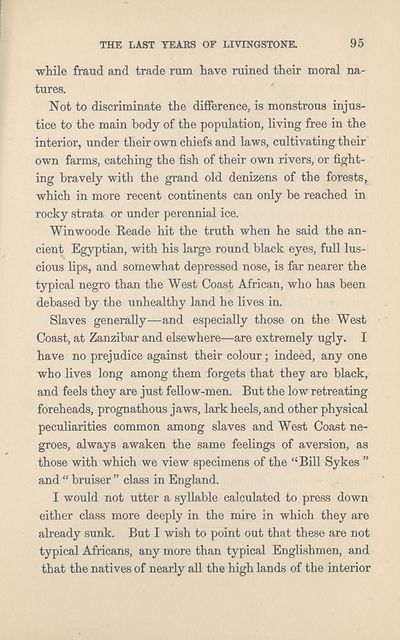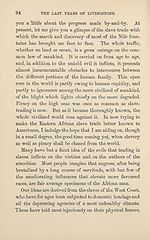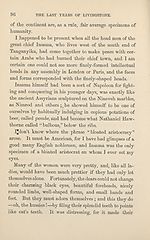Download files
Complete book:
Individual page:
Thumbnail gallery: Grid view | List view

THE LAST TEARS OF LIVINGSTONE.
95
while fraud and trade rum have ruined their moral na¬
tures.
Not to discriminate the difference, is monstrous injus¬
tice to the main body of the population, living free in the
interior, under their own chiefs and laws, cultivating their
own farms, catching the fish of their own rivers, or fight¬
ing bravely with the grand old denizens of the forests,
which in more recent continents can only be reached in
rocky strata or under perennial ice.
Winwoode Reade hit the truth when he said the an¬
cient Egyptian, with his large round black eyes, full lus¬
cious lips, and somewhat depressed nose, is far nearer the
typical negro than the West Coast African, who has been
debased by the unhealthy land he lives in.
Slaves generally—and especially those on the West
Coast, at Zanzibar and elsewhere—are extremely ugly. I
have no prejudice against their colour ; indeed, any one
who lives long among them forgets that they are black,
and feels they are just fellow-men. But the low retreating
foreheads, prognathous jaws, lark heels, and other physical
peculiarities common among slaves and West Coast ne¬
groes, always awaken the same feelings of aversion, as
those with which we view specimens of the “Bill Sykes ”
and “ bruiser ” class in England.
I would not utter a syllable calculated to press down
either class more deeply in the mire in which they are
already sunk. But I wish to point out that these are not
typical Africans, any more than typical Englishmen, and
that the natives of nearly all the high lands of the interior
95
while fraud and trade rum have ruined their moral na¬
tures.
Not to discriminate the difference, is monstrous injus¬
tice to the main body of the population, living free in the
interior, under their own chiefs and laws, cultivating their
own farms, catching the fish of their own rivers, or fight¬
ing bravely with the grand old denizens of the forests,
which in more recent continents can only be reached in
rocky strata or under perennial ice.
Winwoode Reade hit the truth when he said the an¬
cient Egyptian, with his large round black eyes, full lus¬
cious lips, and somewhat depressed nose, is far nearer the
typical negro than the West Coast African, who has been
debased by the unhealthy land he lives in.
Slaves generally—and especially those on the West
Coast, at Zanzibar and elsewhere—are extremely ugly. I
have no prejudice against their colour ; indeed, any one
who lives long among them forgets that they are black,
and feels they are just fellow-men. But the low retreating
foreheads, prognathous jaws, lark heels, and other physical
peculiarities common among slaves and West Coast ne¬
groes, always awaken the same feelings of aversion, as
those with which we view specimens of the “Bill Sykes ”
and “ bruiser ” class in England.
I would not utter a syllable calculated to press down
either class more deeply in the mire in which they are
already sunk. But I wish to point out that these are not
typical Africans, any more than typical Englishmen, and
that the natives of nearly all the high lands of the interior
Set display mode to:
![]() Universal Viewer |
Universal Viewer | ![]() Mirador |
Large image | Transcription
Mirador |
Large image | Transcription
| Antiquarian books of Scotland > Scotland/Scots > Last years of Livingstone > (103) |
|---|
| Permanent URL | https://digital.nls.uk/136058398 |
|---|
| Description | Thousands of printed books from the Antiquarian Books of Scotland collection which dates from 1641 to the 1980s. The collection consists of 14,800 books which were published in Scotland or have a Scottish connection, e.g. through the author, printer or owner. Subjects covered include sport, education, diseases, adventure, occupations, Jacobites, politics and religion. Among the 29 languages represented are English, Gaelic, Italian, French, Russian and Swedish. |
|---|

